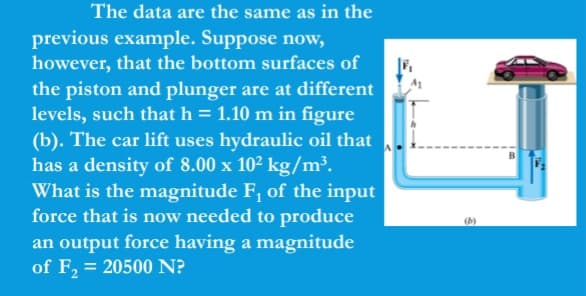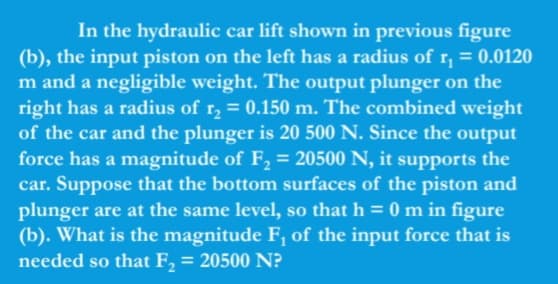In the hydraulic car lift shown in previous figure (b), the input piston on the left has a radius of r1 = 0.0120 m and a negligible weight. The output plunger on the right has a radius of r2 = 0.150 m. The combined weight of the car and the plunger is 20 500 N. Since the output force has a magnitude of F2 = 20500 N, it supports the car. Suppose that the bottom surfaces of the piston and plunger are at the same level, so that h = 0 m in figure (b). What is the magnitude F1 of the input force that is needed so that F2 = 20500 N
1. In the hydraulic car lift shown in previous figure
(b), the input piston on the left has a radius of r1 = 0.0120
m and a negligible weight. The output plunger on the
right has a radius of r2 = 0.150 m. The combined weight
of the car and the plunger is 20 500 N. Since the output
force has a magnitude of F2 = 20500 N, it supports the
car. Suppose that the bottom surfaces of the piston and
plunger are at the same level, so that h = 0 m in figure
(b). What is the magnitude F1 of the input force that is
needed so that F2 = 20500 N?
2. The data are the same as in the
previous example. Suppose now,
however, that the bottom surfaces of
the piston and plunger are at different
levels, such that h = 1.10 m in figure
(b). The car lift uses hydraulic oil that
has a density of 8.00 x 102 kg/m3.
What is the magnitude F1 of the input
force that is now needed to produce
an output force having a magnitude
of F2 = 20500 N?


Trending now
This is a popular solution!
Step by step
Solved in 3 steps with 1 images









